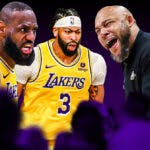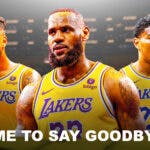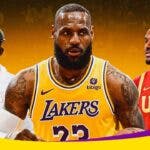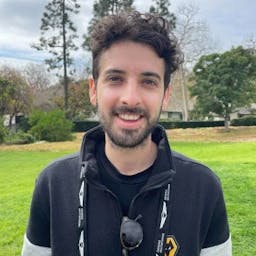Despite not owning any picks following a lottery-bound season, the Los Angeles Lakers will be a factor in the 2022 NBA Draft.
Los Angeles has hosted dozens of prospects for pre-draft workouts. They want to buy into the second round and will seek undrafted players afterward. Of course, trades are always in play. (Update: the Lakers traded for the No. 35 pick!)
Let’s break it all down ahead of the 76th NBA Draft — and first featuring this revamped Lakers coaching staff.
https://open.spotify.com/episode/7LKKen7rCcxI6vMw6PY77d?si=69ad95b67c1d4e59
What happened last year?
The Lakers didn't make a selection in the 2021 NBA Draft, yet, naturally, stole the spotlight. Rob Pelinka (and LeBron James) orchestrated a mid-first-round blockbuster that sent Kyle Kuzma, Montrezl Harrell, Kentavious Caldwell-Pope, and the No. 22 pick (Isaiah Jackson, later flipped to the Indiana Pacers) to the Washington Wizards in exchange for Russell Westbrook and two future second-rounders (2024, 2028).
In the hours following the festivities, the Lakers signed a handful of free agents: Austin Reaves, Mac McClung, Joel Ayayi, and Chaundee Brown. Reaves — who turned down the chance to be selected — became a bright spot while McClung was among the best rookies in the G-League. All four players had conducted pre-draft workouts with the Lakers.
The Lakers have agreed to sign shooting guard Austin Reeves to a two-way contract, according to league sources. He split his college career at Wichita State and Oklahoma.
— Dave McMenamin (@mcten) July 30, 2021
What happened to the 2022 picks?
The Lakers' first-round pick went to the New Orleans Pelicans in the Anthony Davis trade. I doubt anybody involved foresaw it landing at No. 8.
To clear cap space for AD, the Lakers traded the 2022 second-rounder with Mo Wagner and Isaac Bonga to the Wizards (the pick has changed hands numerous times since).
Will the Lakers still make a selection?
The Lakers will attempt to buy at least one second-round pick, per Pelinka.
Los Angeles has $4.7 million in cash available for this type of transaction, per CBA rules. The Lakers have made this move twice over the past decade — purchasing the No. 46 pick on both occasions. In 2014, they paid the Wiz $1.8 million for Jordan Clarkson. In 2019, the Orlando Magic accepted $2.2 million for the Talen Horton-Tucker pick.
Conveniently, the Atlanta Hawks (No. 44) and Detroit Pistons (No. 46) are reportedly open to dealing.
Adding a second-rounder makes sense for the Lakers, considering their scouting department‘s impressive track record and the need to populate the back end of their roster with inexpensive — and ideally, young — players.
Who have the Lakers worked out?
The Lakers have hosted dozens of prospects for workouts at the UCLA Health Training Center, including:
Three UCLA kids (Jules Bernard, Johnny Juzang, Peyton Watson), three sons of ex-NBA players (LSU's Shareef O'Neal, Colorado's Jabari Walker, Vanderbilt's Scotty Pippen Jr.), and two national champions (Kansas' Remy Martin and David McCormack).
“My dad and Kobe won championships when I was born. Now I got the Lakers jersey on. … I got a Lakers No. 6 on. Hopefully LeBron doesn’t get mad.” — Shareef O’Neal pic.twitter.com/CBRNgWlJP6
— Bill Oram (@billoram) June 21, 2022
Cole Swider (Syracuse) — a skilled 6'9 combo forward — is the only player known to have worked out for the Lakers twice.
Here’s who else we know visited El Segundo (who did not withdraw) and where they rank on The Athletic's Sam Vecenie's comprehensive Top-100 draft guide.
- Keve Aluma (Virginia Tech) – NR
- James Akinjo (Baylor) – 80
- Paul Atkinson Jr. (Notre Dame) – NR
- Patrick Baldwin Jr. (Milwaukee) – 43
- Jamaree Bouyea (San Francisco) – 77
- Danko Brankovic (Cibona) – NR
- Terrell Brown Jr. (Washington) – NR
- Jamal Cain (Oakland) – NR
- R.J. Cole (UConn) – NR
- Darius Days (LSU) – 81
- Mike Devoe (Georgia Tech) – 95
- Khalifa Diop (Gran Canaria) – 66
- Kyler Edwards (Houston) – NR
- Keon Ellis (Alabama) – 63
- Phlandrous Fleming Jr. (Florida) – NR
- Grant Golden (Richmond) – NR
- Brison Gresham (Texas Southern) – NR
- Haowen Guo (Shanghai Sharks) – NR
- Jordan Hall (St. Joseph’s) – 69
- Jeriah Horne (Tulsa) – NR
- Quenton Jackson (Texas A&M) – NR
- DeVante’ Jones (Michigan) – NR
- Kur Kuath (Marquette) – NR
- Hyunjung Lee (Davidson) – 64
- Kenneth Lofton Jr. (Louisiana Tech) – 98
- Tyrese Martin (UConn) – 68
- Trey McGowens (Nebraska) – NR
- Javante McCoy (BU) – NR
- Wendell Moore Jr. (Duke) – 31
- Malik Osborne (Florida St.) – NR
- Gaige Prim (Missouri St.) – NR
- Lester Quinones (Memphis) – NR
- Orlando Robinson (Fresno St.) – 74
- Jermaine Samuels (Villanova) – 97
- Jaden Shackelford (Alabama) – NR
- Michael Steadman (UMass) – NR
- Jordan Usher (Georgia Tech) – NR
- Isaiah Whaley (UConn) – NR
- Fabian White Jr. (Houston) – NR
- Jeenathan Williams (Buffalo) – 94
- Trevion Williams (Purdue) – 51
- Lucas Williamson (Loyola Chicago) – 96
As you'll see, the Lakers primarily auditioned players projected to go late or undrafted (the Lakers publicly disclose most, but not all, of their workouts).
Moore Jr. was a five-star prospect who surprisingly played for Coach K for three years. He won the Julius Erving Award as a junior — given to the nation's best small forward — and averaged 14.8 points, 4.6 rebounds, and 3.5 assists on scorching .471/.423/.931 splits in the ACC tournament through the Final Four. He was All-Conference on D, too.
Walker, the son of former Lakers champ Samaki, is a 6'8, high-motor wing with above-average defensive versatility and instincts. His near-40% three-point clip in college is encouraging.
Jabari Walker says even though his dad Samaki Walker played for the Lakers that he wasn't a fan of the team. "I was a LeBron fan, so wherever LeBron was, that was the team I was rooting for."
— Ryan Ward (@RyanWardLA) June 14, 2022
Similarly, Ellis is a high-activity two-way wing (6'6) with solid three-point shooting output who can wreak havoc on the ball. As an older prospect, he's a safer bet to help right away. Ellis and Walker are intriguing sleepers.
Patrick Baldwin Jr. had a miserable lone season playing for his dad at Milwaukee. He struggled to hit shots (26.6% from 3) — the poor guard play around him didn't help, and none of his looks were open — before being shut down with an ankle injury after 11 games. However, the upside is obvious. The former McDonald's All-American is massive for a wing (6'10, 7'2 wingspan). His shooting stroke is high and smooth, and he has all the moves, tricks, and instincts to score any which way in the halfcourt.
Trevion Williams, at 6'10, 265, offers limited shooting range and a concerning proclivity for fouling, but he's a former Big Ten Sixth Man of the Year and First Team selection. Lakers draft guru Mike Garcia considers Williams arguably the premier passer in his class.
I also ride with Garcia as a fan of Hyunjung Lee, particularly as a useful supporting piece around stars. Here's what Garcia wrote in his Substack:
“He’s not a super explosive player, but what I appreciate about his game is his total focus to off-ball play, screen utilization, movement shooting, and 3-point gravity.”
Jamal Cain could make sense, as well. He's one of the older prospects in the draft, having played a year at Oakland after four at Marquette. That could be a good thing for a Lakers team looking to win now (see: Reaves, Austin). The 6'7 wing shot 35.1% from three as a collegian and averaged 19.9 points and 10.2 boards for the Golden Grizzlies.
Finally, Jordan Hall fits the bill: At 6'9, he averaged 14.1 points per game in 2021-22 and shot 35.8% from deep for the Red Storm.
A few (of many) other names to watch: David Roddy (Colorado State), Vince Williams Jr. (VCU), Julian Champagnie (St. John's). If MarJon Beauchamp (Ignite), Nikola Jovic (Serbia), or Jake Laravia (Wake Forest) slide, the Lakers could try and offer more money (and a future second, perhaps) for a higher second-round pick.
Whom should they target?
The Lakers' priority this offseason has to be to get more energetic, athletic, and versatile on the wing. Obviously, the more 3er-and-Der, the better. At some point, they'll have to address backup center and point guard, too.
But, with so many holes to fill, the need for depth across the board, still-TBD questions about the roster, and limited free agency options, the Lakers don't need to over-emphasize fit on Thursday. It’s unlikely that any late-round/undrafted rookie will move the needle in 2022-23, anyway. Best-case scenario, you land a contributing role player, à la Reaves.
Take the best player — and culture fit — available. And, when in doubt: roll with large wings.




